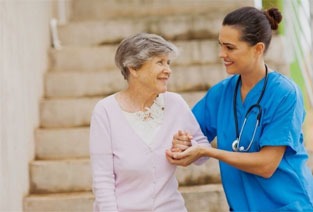Fall Prevention in Elderly at Home
How to prevent falls in the elderly at home
Facts: Elderly do fall more often but falls are not part of normal aging.
Fact: There are many studies that have demonstrated that falls are the number one cause of injuries in seniors at home.
Top four reasons why falls in the elderly needs to be investigated and prevented
1- Fall in the elderly can result in fractures, cuts, bruises, head and brain injuries, and other complications.
2- Hip fractures are a common occurrence post-fall because many seniors suffer from osteoporosis. Pending senior’s general health condition many seniors need to have an operation to replace the fractured hip with an artificial hip.
3- Many elderly that are living alone do fall and they stay down on the cold floor for hours and days before someone finds out about their falls and to call for help. Such an extended period of being on the cold floor can be medically and emotionally destructive.
4- Fall can result in permanent injuries, hospitalization, and death.
Factors that contribute to fall in seniors
Physiological changes in the elderly contributing to falling:
1- Poor balance when walking
2- Inadequate vision
3- Loss of sensation, particularly in the feet
4- Loss of muscle strength
5- Impaired cognition
6- Low blood pressure and or irregular heartbeat
7- Neurological disorders and deficiencies such as Parkinson and stroke
8- Effect and side effect of medications, such as opioid pain killers, Sedatives, antidepressant drugs, and heart-related medications
Environmental factors contributing to fall
1- Inadequate lighting
2- Lose rugs
3- Slippery floors
4- Lose objects and electrical or extension cords than can cause tipping when they are walking
5- Lack of grab bars and non-slippery mats in the bathrooms and kitchens
6- Stairs
7- Cluttered environment
10 recommendations to reduce the risk of falls in seniors at home
1- Visit a medical doctor for a complete physical check-up, laboratory test, and medication review
2- Visit an eye doctor to test vision and obtain a proper eyewear
3- Consult an occupational therapist. House needs to be retrofitted with grab bars, poles, railings, and a raised toilet seat. Shower and bath needs to be retrofitted with accessories to avoid slippage and falls
4- Consult a physical therapist to teach exercises and to suggest assistive devices such as cane or walker
5- Obtain a proper foot wear
6- Use non-slip mats in the bathroom and kitchen
7- Uncluttered the environment
8- Remove and secure loose objects and wiring
9- Improve lighting throughout the house
10- Avoid climbing up and down the stairs or have a professionally installed stair case
Despite all measures falls in the elderly can still happen. If a senior is at high risk of falls despite all interventions then it might be necessary to hire a companion or a caregiver to stay nearby to avoid falls.
